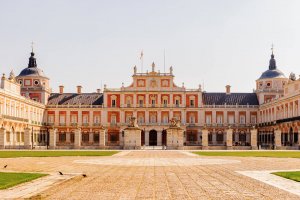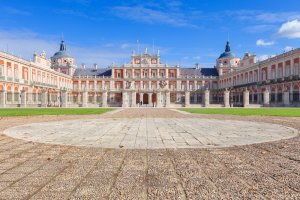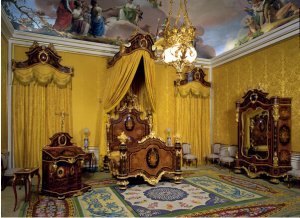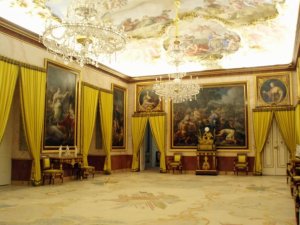A Look Inside The Royal Palace of Aranjuez

We can’t talk about classical-style decoration without giving a special mention to the Royal Palace of Aranjuez. Inside, you can find many stunning classical features, which have made the palace a reference point for classic modern interior decor.
The architects who designed the palace took inspiration from classical French architecture, which found popularity in the 17th and 18th centuries. This classical style eventually made its way to Spain, and its influence can be seen not just at Aranjuez, but also in the Royal Palace of Madrid.
Modern interior decorators continue to use elements of classical architecture in their designs. The baroque style has served as inspiration for interior designers around the world, who continue to produce works inspired by palaces of the time.
The Royal Palace of Aranjuez – history

Construction of the palace started back in the 16th century, during the reign of Felipe II. He put architect Juan Bautista de Toledo in charge of the project, although later, architect Juan de Herrera also got involved.
Problems began in the 17th century when work on the palace ground to a halt. Work only began again during the reign of Felipe V, at the beginning of the 18th century. However, a fire destroyed the building not long after. Responsibility for its reconstruction then fell to King Fernando VI, who assigned the task to architect Santiago Bonavía.
Later, during the reign of Carlos III, renowned architect Francisco Sabatini began work to extend the palace. Using the Versailles style, he created two luxurious west wings, designed to portray Spain’s majesty and political dominance.
The Palace of Aranjuez is a World Heritage site.
Queen Isabel II’s chambers

One of the most peculiar, yet interesting rooms in the palace is Queen Isabel II’s bedchamber. This room boasts a strange mish-mash of features that set it apart from other royal bedrooms.
- Mustard yellow is the dominant color in this room, featuring on both the wall hangings and the richly decorated carpet. This color isn’t all that common today and serves as a distinguishing point between classical and modern classic decor.
- The gold tones found on the furniture and the chandelier complement the mustard yellow beautifully. The rich, brown color of the wooden furniture serves as a counterpoint to the gold, making it stand out even more, and giving the room a feeling of warmth. This is a room full of luxury and ostentation.
- On the ceiling, you can find a great example of an illusionistic ceiling painting, typical of classical and baroque era decor.
- Every inch of this room is sumptuously decorated, filled with rich fabrics and colors. But what really stands out is the ornate and elaborately curving furniture, characteristic of the rococo style.
The Royal Palace of Aranjuez: the billiard room

Whoever said that billiards was a modern invention? As you can see, the Palace of Aranjuez has an entire room dedicated entirely to the game. What’s more, the designer has created a space unlike any games room you would see today.
In a display of horror vacui, every inch of this room is painstakingly decorated, with geometric shapes, animals, and decorative patterns covering the walls. The use of cool colors like white and blue tempers the warm salmon and ocher tones of the wood.
The billiard table itself is richly decorated, with elegant gilded arches and moldings. This “alternative elegance” is characteristic of the classical French style.
The music antechamber: art and decoration

Here again we see the use of mustard yellow in both the curtains and furniture, while the floor is covered with light brown carpeting. There are large paintings and portraits lining the walls, and more illusionistic decor across the high ceiling.
The only contrast to all these light tones is the deep red wainscoting lining the lower half of the walls. This helps give the room certain warmth, and acts as a counterpoint to the prevailing yellow and cream tones.
We can’t talk about classical-style decoration without giving a special mention to the Royal Palace of Aranjuez. Inside, you can find many stunning classical features, which have made the palace a reference point for classic modern interior decor.
The architects who designed the palace took inspiration from classical French architecture, which found popularity in the 17th and 18th centuries. This classical style eventually made its way to Spain, and its influence can be seen not just at Aranjuez, but also in the Royal Palace of Madrid.
Modern interior decorators continue to use elements of classical architecture in their designs. The baroque style has served as inspiration for interior designers around the world, who continue to produce works inspired by palaces of the time.
The Royal Palace of Aranjuez – history

Construction of the palace started back in the 16th century, during the reign of Felipe II. He put architect Juan Bautista de Toledo in charge of the project, although later, architect Juan de Herrera also got involved.
Problems began in the 17th century when work on the palace ground to a halt. Work only began again during the reign of Felipe V, at the beginning of the 18th century. However, a fire destroyed the building not long after. Responsibility for its reconstruction then fell to King Fernando VI, who assigned the task to architect Santiago Bonavía.
Later, during the reign of Carlos III, renowned architect Francisco Sabatini began work to extend the palace. Using the Versailles style, he created two luxurious west wings, designed to portray Spain’s majesty and political dominance.
The Palace of Aranjuez is a World Heritage site.
Queen Isabel II’s chambers

One of the most peculiar, yet interesting rooms in the palace is Queen Isabel II’s bedchamber. This room boasts a strange mish-mash of features that set it apart from other royal bedrooms.
- Mustard yellow is the dominant color in this room, featuring on both the wall hangings and the richly decorated carpet. This color isn’t all that common today and serves as a distinguishing point between classical and modern classic decor.
- The gold tones found on the furniture and the chandelier complement the mustard yellow beautifully. The rich, brown color of the wooden furniture serves as a counterpoint to the gold, making it stand out even more, and giving the room a feeling of warmth. This is a room full of luxury and ostentation.
- On the ceiling, you can find a great example of an illusionistic ceiling painting, typical of classical and baroque era decor.
- Every inch of this room is sumptuously decorated, filled with rich fabrics and colors. But what really stands out is the ornate and elaborately curving furniture, characteristic of the rococo style.
The Royal Palace of Aranjuez: the billiard room

Whoever said that billiards was a modern invention? As you can see, the Palace of Aranjuez has an entire room dedicated entirely to the game. What’s more, the designer has created a space unlike any games room you would see today.
In a display of horror vacui, every inch of this room is painstakingly decorated, with geometric shapes, animals, and decorative patterns covering the walls. The use of cool colors like white and blue tempers the warm salmon and ocher tones of the wood.
The billiard table itself is richly decorated, with elegant gilded arches and moldings. This “alternative elegance” is characteristic of the classical French style.
The music antechamber: art and decoration

Here again we see the use of mustard yellow in both the curtains and furniture, while the floor is covered with light brown carpeting. There are large paintings and portraits lining the walls, and more illusionistic decor across the high ceiling.
The only contrast to all these light tones is the deep red wainscoting lining the lower half of the walls. This helps give the room certain warmth, and acts as a counterpoint to the prevailing yellow and cream tones.
All cited sources were thoroughly reviewed by our team to ensure their quality, reliability, currency, and validity. The bibliography of this article was considered reliable and of academic or scientific accuracy.
- Junquera de la Vega, Paulina; Ruiz Alcón, María Teresa: Guía ilustrada del Real Palacio de Aranjuez, Patrimonio Nacional, 1958.







